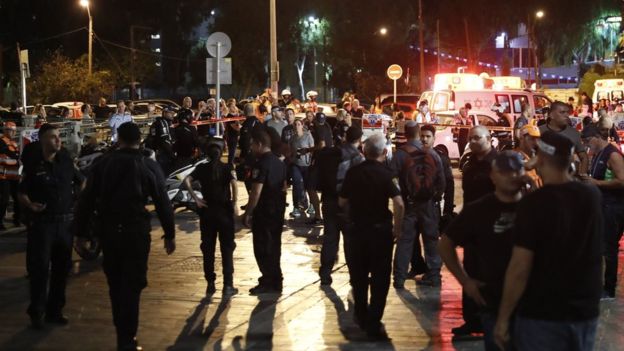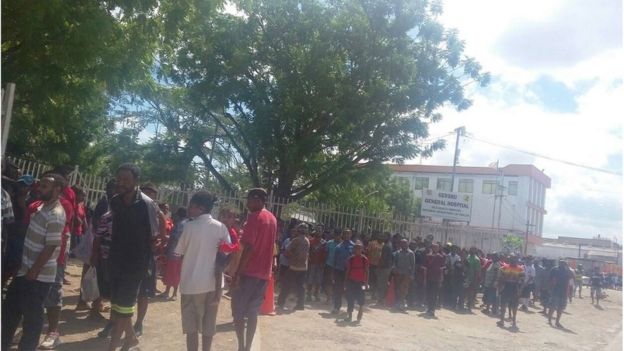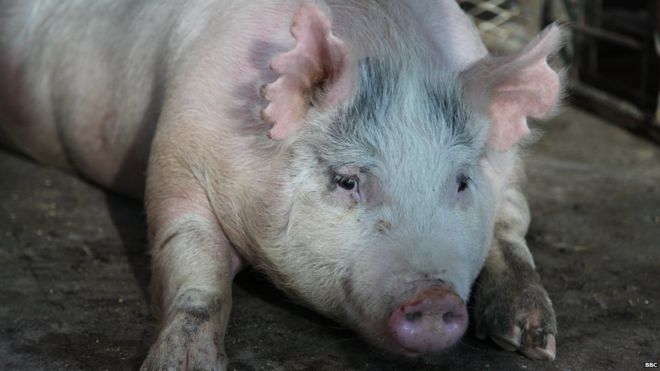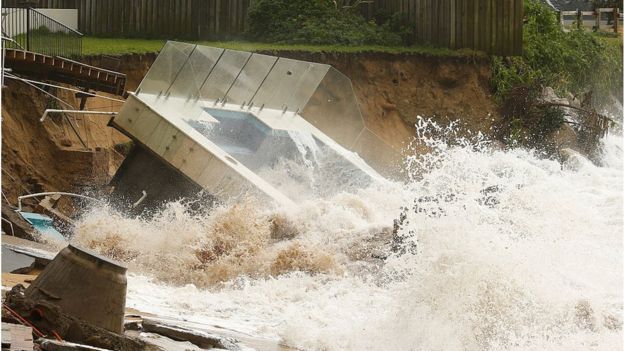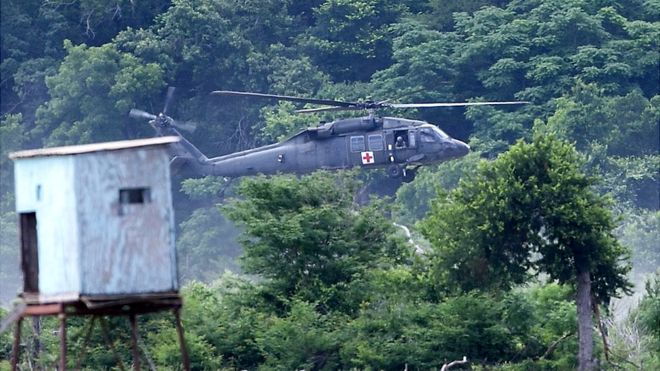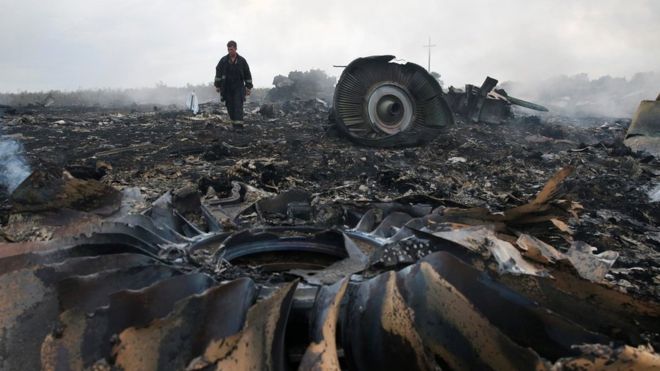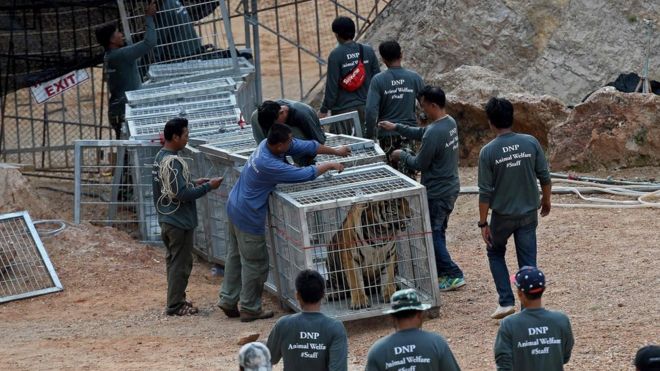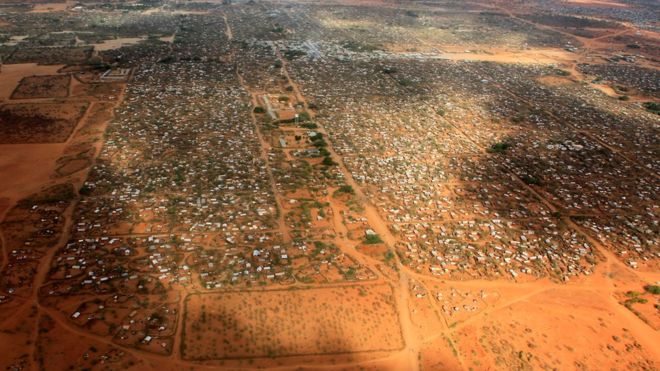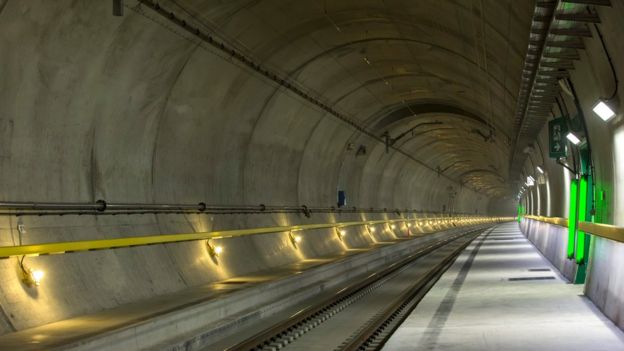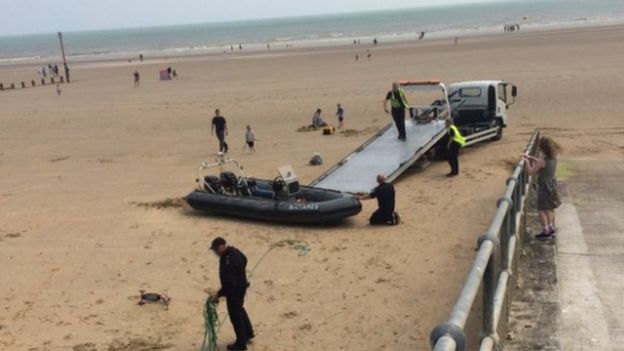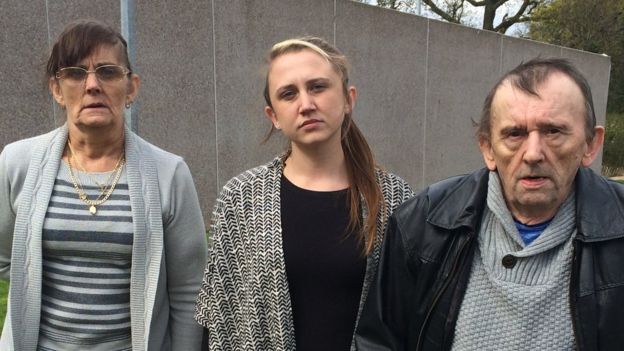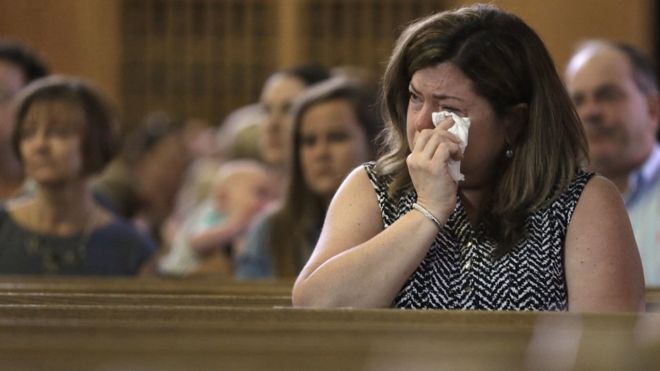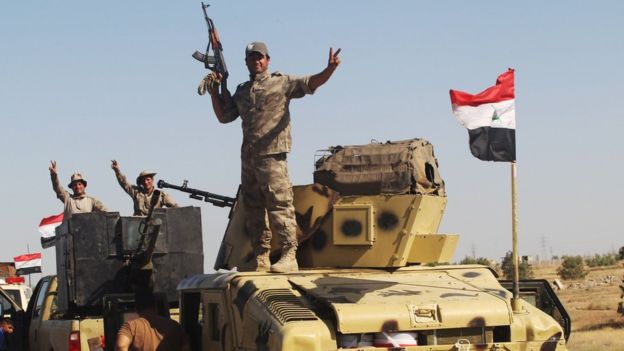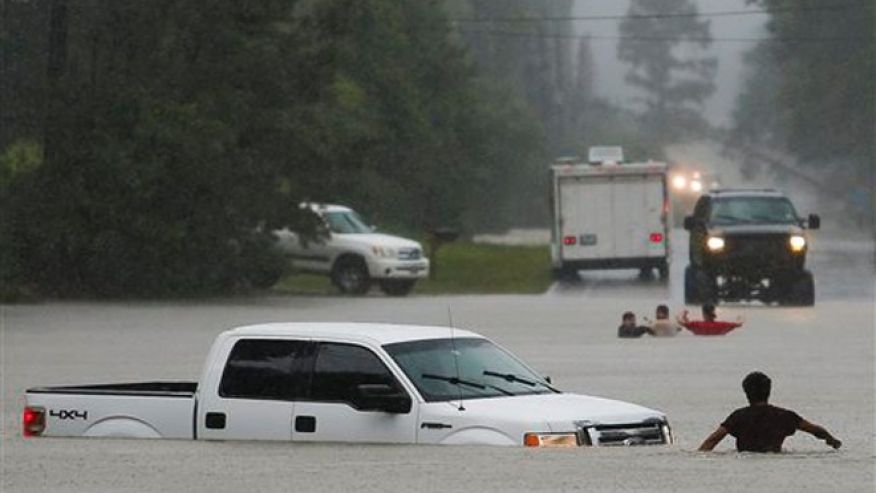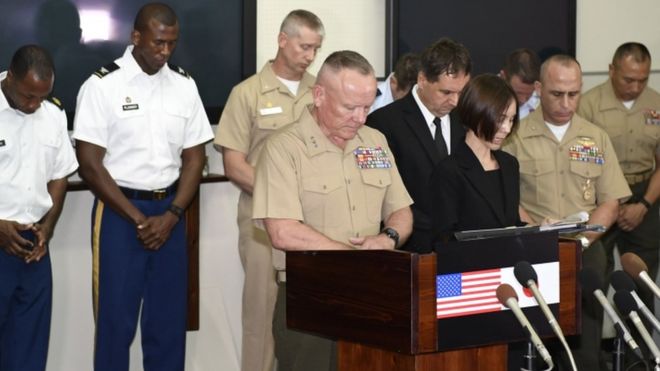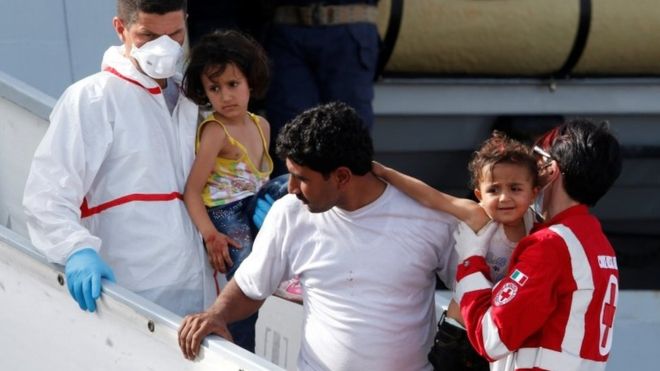General News
Tel Aviv shooting: Four killed in shopping centre attack
Two Palestinian gunmen killed four people and wounded six others after opening fire at a popular open-air shopping and restaurant area of central Tel Aviv, Israeli authorities say.
The attacks took place in two locations in Sarona Market, close to Israel's defence ministry and main army HQ.
Police said the gunmen were from Yatta, a Palestinian village near the West Bank town of Hebron.
Both are in custody. One is undergoing surgery in hospital, police added.
There has been a rise in Palestinian attacks on Israelis since last year, with a series of shootings, stabbings and car rammings, although the number of incidents had dropped in recent months.
Prime Minister Benjamin Netanyahu, who visited the scene of the attack late on Wednesday, called it "a savage crime of murder and terrorism".
'Ran like lightning'
The attacks happened at around 21:30 (18:30 GMT) as people were relaxing in the market's restaurants and bars.
Video footage showed crowds running from the scene and ambulances arriving. Pictures showed upturned tables and chairs at one restaurant.
One woman told Israel's Channel 10 TV that she had been celebrating her son's birthday when she heard shots and "immediately understood it was a terror attack".
"We ran like lightning with the baby and the stroller," Meital Sassi said. "I yelled at people who didn't understand what was happening to run."
Ichilov hospital said four wounded people brought there had died and at least others were in a critical condition.
Tel Aviv police chief Chico Edri called it a "pretty serious terrorist incident" but said fears of a third attacker were unfounded.
"Two terrorists arrived at the complex and while firing, and to our regret, nine people were injured to different degrees," he said.
"Of the two terrorists, one was arrested and the other wounded by gunfire. The weapons they were carrying have been seized."
The director of the market, Shlomi Hajaj, told Channel 10 that security guards at the entrance had "prevented the attackers from entering the facility, averting a bigger disaster as the compound was packed with people".
"I think a larger tragedy was avoided by the resolute action of citizens, of security people, police," said Mr Netanyahu.
"We're going to take the necessary steps to attack the attackers and defend those who need to be defended."
Source: bbc.com
- Read more
-
09/Jun/2016
Papua New Guinea police open fire on student protest
Police in Papua New Guinea have opened fire on students protesting against Prime Minister Peter O'Neill.
Several students were injured but local media say there have been no fatalities.
They were marching from their campus in the capital, Port Moresby, towards parliament, where Mr O'Neill faces a possible motion of no confidence.
The students are demanding that he stand down over corruption allegations, which he denies.
Footage obtained by the BBC appeared to show a large crowd of students at the campus running away as shots and tear gas were fired.
Medical officials in Port Moresby told Reuters that at least 10 students had been admitted "in a difficult situation".
Images circulating on social media also showed injured students being carried away.
What are the students protesting about?
Political tension in the country has been rising for weeks, with thousands of students at the University of Papua New Guinea boycotting classes demanding the resignation of PM O'Neill over alleged corruption. Classes were officially suspended last month.
What has Peter O'Neill said?
In May, Mr O'Neill responded to a petition from students saying that he would not be resigning. He said the corruption allegations against him were of "questionable political intent", as reported by ABC.
Why is PNG so turbulent?
Papua New Guinea was ranked one of the most corrupt countries in the world in 2012 by Transparency International.
In 2014, Mr O'Neill himself was accused of fraud by the national anti-corruption watchdog, which issued a warrant for his arrest. The warrant has not been carried out so far.
According to the World Bank, 70% of the country, the most linguistically diverse in the world, lives in poverty.
One eyewitness, David Rupa, told the BBC he was on his way to work when he became caught in the protest at about 08:50 local time (23:50 GMT Tuesday).
He said he could see tear gas and people running for cover and heard shots fired.
"I saw policemen hit and kick girls who couldn't run [fast enough] and were bashed up. I cried and was told I will be shot if I was going to take photos or video."
He also said he had seen smoke coming from a dormitory at the university, and that parents were coming down to the campus to make sure their children were not hurt.
Gary Juffa, an MP and vocal critic of the prime minister, said on Twitter he had been told the shooting began with an argument between one student and a police superintendent.
Reports suggest the students had refused to hand over their protest leader to police.
Opposition figures told parliament that four people had died, while some reports said one person was dead. But local news site EMTV told the BBC there had been no confirmed fatalities.
EMTV said the university had suspended classes to deal with the student boycott, but they were supposed to resume this week.
The students were continuing their boycott, however, as opposition parties lodged a no confidence motion against Mr O'Neill.
Mr O'Neill, who has a majority in parliament, has consistently denied wrongdoing and has refused to stand down.
Source: bbc.com
- Read more
-
07/Jun/2016
Scientists grow human organs for transplant inside pigs
Scientists in the United States are trying to grow human organs inside pigs.
They have injected human stem cells into pig embryos to produce human-pig embryos known as chimeras.
The embryos are part of research aimed at overcoming the worldwide shortage of transplant organs.
The team from University of California, Davis says they should look and behave like normal pigs except that one organ will be composed of human cells.
The human-pig chimeric embryos are being allowed to develop in the sows for 28 days before the pregnancies are terminated and the tissue removed for analysis.
The BBC's Panorama was given exclusive access to the research for Medicine's Big Breakthrough: Editing Your Genes.
Creating a chimera
Creating the chimeric embryos takes two stages. First, a technique known as CRISPR gene editing is used to remove DNA from a newly fertilised pig embryo that would enable the resulting foetus to grow a pancreas.
This creates a genetic "niche" or void. Then, human induced pluripotent (iPS) stem cells are injected into the embryo. The iPS cells were derived from adult cells and "dialled back" to become stem cells capable of developing into any tissue in the body.
The team at UC Davis hopes the human stem cells will take advantage of the genetic niche in the pig embryo and the resulting foetus will grow a human pancreas.

Human stem cells being injected into a pig embryo - the cells can be seen travelling down the tube on the right of screen
Pablo Ross, a reproductive biologist who is leading the research told me: "Our hope is that this pig embryo will develop normally but the pancreas will be made almost exclusively out of human cells and could be compatible with a patient for transplantation."
But the work is controversial. Last year, the main US medical research agency, the National Institutes of Health, imposed a moratorium on funding such experiments.
The main concern is that the human cells might migrate to the developing pig's brain and make it, in some way, more human.
Pablo Ross says this is unlikely but is a key reason why the research is proceeding with such caution: "We think there is very low potential for a human brain to grow, but this is something we will be investigating."
Biological incubator
His team has previously injected human stem cells into pig embryos but without first creating the genetic niche. Prof Ross said although they later found human cells in several parts of the developing foetus, they "struggled to compete" with the pig cells. By deleting a key gene involved in the creation of the pig pancreas, they hope the human cells will have more success creating a human-like pancreas.
Other teams in the United States have created human-pig chimeric embryos but none has allowed the foetuses to be born.
Walter Low, professor in the department of neurosurgery, University of Minnesota, said pigs were an ideal "biological incubator" for growing human organs, and could potentially be used to create not just a pancreas but hearts, livers, kidneys, lungs and corneas.
He said if the iPS cells were taken from a patient needing a transplant then these could be injected in a pig embryo which had the key genes deleted for creating the required organ, such as the liver: "The organ would be an exact genetic copy of your liver but a much younger and healthier version and you would not need to take immunosuppressive drugs which carry side-effects."
But Prof Low stressed that the research, using another form of gene editing called TALENs, was still at the preliminary stages, trying to identify the target genes which must be removed in order to prevent the pig from developing a particular organ.
His team is also trying to create dopamine-producing human neurons from chimeric embryos to treat patients with Parkinson's disease.
These embryos have been allowed to develop for up to 62 days - the normal gestation period is around 114 days.
Like the team in California, Prof Low said they were monitoring the effects on the pig brain: "With every organ we will look at what's happening in the brain and if we find that it's too human like, then we won't let those foetuses be born".
Animal viruses
Gene editing has revitalised research into xenotransplantation, and the concept of using animal organs for humans.
In the mid-90s there were hopes that genetically modified pigs might provide an endless supply of organs for patients, and that cross-species transplants were not far off.
But clinical trials stalled because of fears that humans might be infected with animal viruses.
Last year, a team at Harvard Medical School used CRISPR gene editing to remove more than 60 copies of a pig retrovirus.
Prof George Church, who led the research, told me: "It opens up the possibility of not just transplantation from pigs to humans but the whole idea that a pig organ is perfectible.
"Gene editing could ensure the organs are very clean, available on demand and healthy, so they could be superior to human donor organs."
Animal suffering
But organisations campaigning for an end to factory farming are dismayed at the thought of organ farms.
Peter Stevenson, from Compassion in World Farming, told me: "I'm nervous about opening up a new source of animal suffering. Let's first get many more people to donate organs. If there is still a shortage after that, we can consider using pigs, but on the basis that we eat less meat so that there is no overall increase in the number of pigs being used for human purposes."
In Greek mythology, chimeras were fire-breathing monsters composed of several animals - part lion, goat and snake. The scientific teams believe human-pig chimeras should look and behave like normal pigs except that one organ will be composed of human cells.
Scott Fahrenkrug, whose Minnesota-based company Recombinetics is teaming up on the chimera research with Prof Low, told me: "Perhaps the term chimera is going to take on a new meaning and it will be one that's much more affectionate: chimeras will be seen to be what they are which is a saviour, given that they will provide, life-saving, sustaining organs for our patients."
Seven thousand people in the UK are on the transplant waiting list and hundreds die each year before a donor can be found.
Source: bbc.com
- Read more
-
06/Jun/2016
Australia storm leaves three dead and homes in danger
Three people are confirmed dead after massive storms flooded rivers, uprooted trees and tore into beaches along Australia's east coast.
Rain and wind continue to batter southern New South Wales, Victoria and Tasmania.
Erosion at Sydney's Collaroy Beach has forced the evacuation of multi-million dollar homes, which are now in danger of collapsing.
The storms cut power to 86,000 homes in New South Wales at the weekend.
On Monday morning, a man's body was found in the Cotter River near Canberra. Police said the 37-year-old was caught in floodwaters at a river crossing.
Police divers have also retrieved the bodies of two men whose cars were washed off roads in separate incidents.
A 65-year-old man was caught inside his vehicle at Bowral, while another man was killed after his utility vehicle was washed off the road on Sydney's south-west fringe.
Flood warnings have been issued across several states, with northern Tasmania facing its worst flooding in decades on Monday.
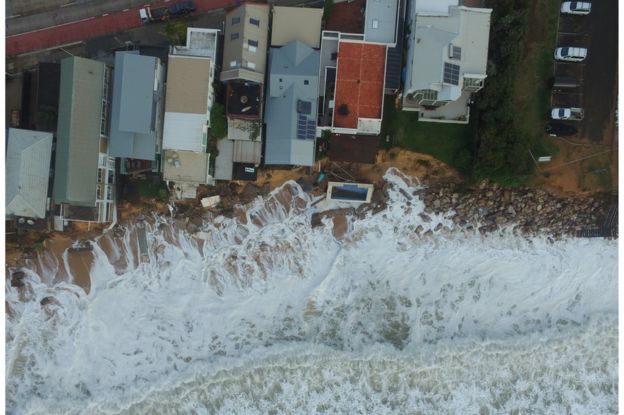
A swimming pool attached to a mansion at Collaroy has collapsed on the beach and residents have been evacuated from waterside mansions
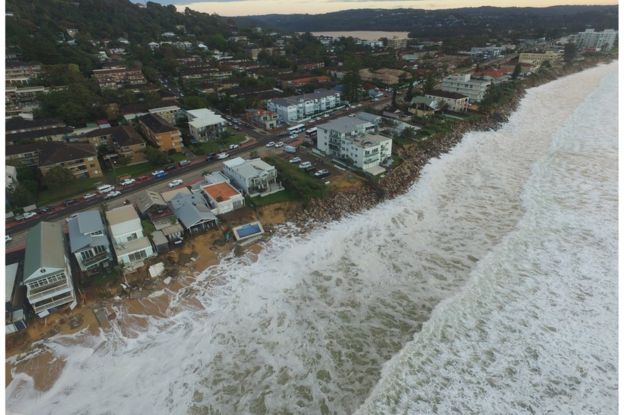
Collaroy, located in Sydney's north, is considered a prestigious suburb, but the beach is considered an erosion hotspot
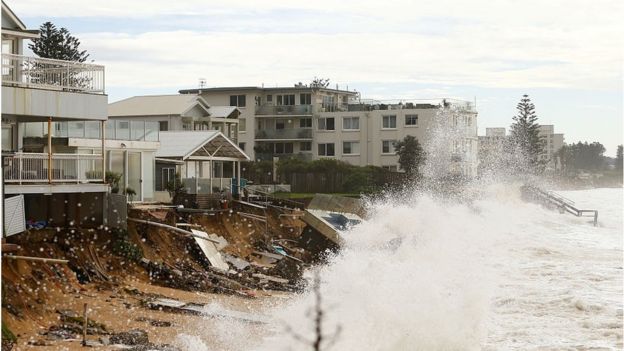
Another king tide is expected to hit Collaroy Beach on Monday and residents have been evacuated
Source: bbc.com
- Read more
-
06/Jun/2016
US journalist and translator killed in Afghan ambush
A veteran US photojournalist and a translator have been killed in Helmand province in southern Afghanistan.
David Gilkey of National Public Radio (NPR) and Zabihullah Tamanna were travelling with the Afghan army when they came under fire and their vehicle was hit by a shell, NPR said.
The attack also killed the driver of the vehicle, an Afghan soldier.
Two other NPR employees travelling with the pair were unharmed, the US public radio network said in a statement.
The vehicle Mr Gilkey, 50, and Mr Tamanna, 38, were travelling in was struck by shellfire near the town of Marjah, NPR said.
Mr Tamanna was a photographer and journalist in Afghanistan, as well as a translator.
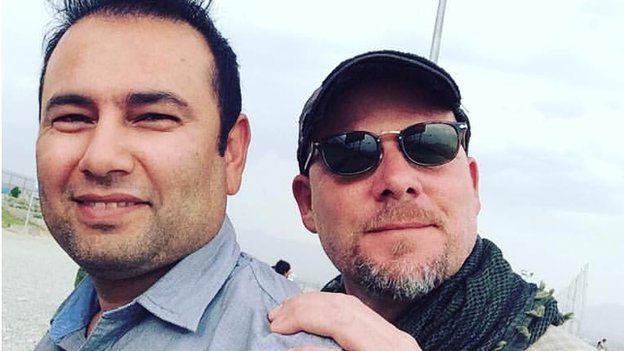
Zabihullah Tamanna (left), pictured with David Gilkey, also worked as a photographer
Michael Oreskes, senior vice president at NPR, paid tribute to the photographer.
He said: "David has been covering war and conflict in Iraq and Afghanistan since 9/11. He was devoted to helping the public see these wars and the people caught up in them. He died pursuing that commitment.
"As a man and as a photojournalist, David brought out the humanity of all those around him. He let us see the world and each other through his eyes."
Mr Gilkey is the first US journalist outside the military to be killed in the conflict in Afghanistan.
He received a series of awards during his career, including a 2007 national Emmy for a video series about US Marines from Michigan serving in in Iraq.
In 2011, he was named still photographer of the year by the White House Photographers' Association, one of nine first-place awards he received from the body.
His work on an investigation into veteran medical care and his coverage of the Ebola crisis helped secure awards for NPR.
Last year, he received the Edward R Murrow Award for his coverage of international breaking news, military conflicts and natural disasters.
Source: bbc.com
- Read more
-
06/Jun/2016
Fort Hood: Bodies of soldiers missing in Texas floods found
The bodies of four missing US soldiers have been recovered after their vehicle overturned while crossing a flooded riverbank at Fort Hood, Texas.
The discovery brings the death toll from the accident to nine.
Three soldiers were found dead shortly after the incident and two more bodies were recovered late on Thursday night.
Foot Hood officials said the 2.5-ton vehicle was conducting a routine exercise when it was swept away by the current amid heavy flooding.
Three of the occupants survived and were discharged from Fort Hood's hospital on Friday.
The four bodies were found downstream from the Owl Creek Tactical Crossing where the vehicle was swept away, said Maj Gen John Uberti, deputy commander at Fort Hood.
The army has not identified any of the victims while it notifies relatives.
"This tragedy extends well beyond Fort Hood and the outpouring of support from the country is sincerely appreciated," said Gen Uberti.
The Light Medium Tactical Vehicle was at a low-water crossing point when it was swept away, said Fort Hood spokesman Chris Haug.
The vehicle was in the "proper place for what they were training", Mr Haug said, adding: "It's just an unfortunate accident that occurred quickly."
Aircraft, canine search teams and swift-water rescue watercraft were deployed to sweep the 20-mile (32km) Owl Creek for the missing soldiers.
News of the deaths comes as torrential rains and flooding continue to grip large swathes of Texas. May saw record-breaking downpours. At least six people have died as a result.
Gov Greg Abbott declared a state of disaster in 31 counties across Texas. Severe storms were expected to hit the state Friday and Saturday, intensifying floods caused by swelling waterways and rivers.
Source: bbc.com
- Read more
-
04/Jun/2016
MH17 crash: Prosecutors increase pressure on Russia
Prosecutors have sought to put pressure on Russia to provide information about the downing of Malaysia Airlines Flight MH17 over eastern Ukraine in July 2014.
They said they wanted information about the Buk missile that shot down the airliner, killing 298 people on board.
The criminal inquiry was at "a very advanced stage", they said, and results would be presented after the summer.
The West and Ukraine say Russian-backed rebels were responsible but Russia accuses Ukrainian forces.
In a statement, the Dutch-led prosecutors said they had made "several requests" for assistance - but were still waiting for information from Moscow.
They said a few issues, including forensic tests, were taking more time than expected.
However, the first conclusions regarding the type of the weapon used and the exact launch site are expected to be published in autumn.
Ongoing cases
Flight MH17 from Amsterdam to Kuala Lumpur crashed at the height of the conflict between Ukrainian government troops and pro-Russian separatists.
Last year, a Dutch report concluded it was downed by a Russian-made Buk missile, but did not say who fired it.
Some families of the victims are suing Russia and its President Vladimir Putin in the European Court of Human Rights.
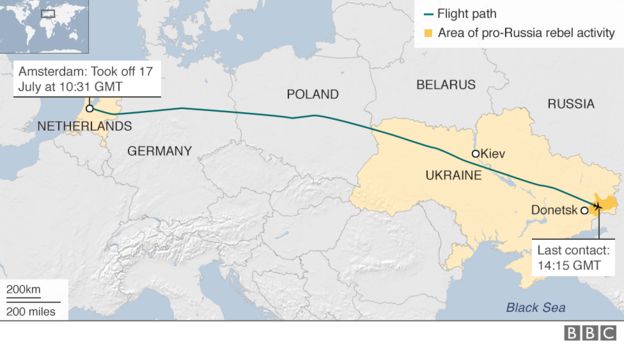
Their claim is based on the violation of a passenger's right to life, News.com.au reported earlier this month.
They are seeking A$10 million Australian dollars ($7.2m; £4.9m) for each victim, and the lawsuit names both the Russian state and its president as respondents.
A senator with Mr Putin's party was quoted in state media as saying the claim was "legally nonsensical and has no chance".
Separately, families of six Malaysia Airlines crew members who were killed filed a lawsuit on Thursday blaming the carrier for the tragedy.
They accuse the company of negligence and breach of contract.
Source: bbc.com
- Read more
-
03/Jun/2016
Paris floods: Seine at 30-year high as galleries close
The River Seine in Paris is at its highest level for more than 30 years, with floods forcing closed parts of the metro systems and major landmarks.
The Louvre and Orsay museums were shut while staff moved artworks to safety as flood levels climbed above 6m (18ft).
The Seine is set to reach as high as 6.5m and unlikely to recede over the weekend, with more downpours forecast.
At least 15 people have died across central Europe as heavy rainfall caused flooding from France to Ukraine.
While two people died in France, 10 were killed in southern Germany as several towns were devastated.
Two more fatalities were reported in Romania and one in Belgium. Austria, the Netherlands and Poland have also been affected.
Tens of thousands of people have been forced from their homes.
The flooding could cost French insurance companies more than 600 million euros (£470m), according to the industry association AFA.
In Paris, the Cluny - La Sorbonne and St Michel metro stations were closed as a precaution while the river spilled onto the city's streets.
Bridges were closed and non-emergency boats were banned from the Seine as its swelling forced the closure of museums, parks and cemeteries.
At the Louvre, curators scrambled to move 250,000 artworks to higher ground from basement storage areas at risk of inundation from what President Francoise Hollande called "exceptional flooding".
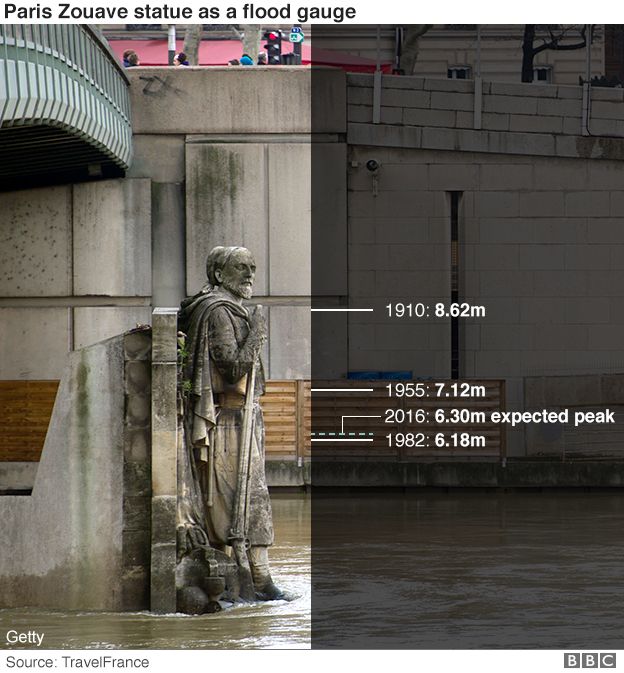
Authorities have even taken initial steps to transfer the presidency and key ministries to secure areas, AP news agency reported.
An apparent equipment fault led to the river's depth being wrongly measured for several hours on Friday.
Many locals have preferred to benchmark the rise against the statue of a soldier - known as the Zouave - standing below the Alma bridge: His frame is currently submerged up to the waist.
While France's rainfall levels in May were the highest since 1873, the current crisis is eclipsed by the 1910 floods that saw Paris submerged for two months, when the Zouave was up to his neck in the Seine.
The river level peaked at 8.62m that year, and has since reached 7.1m in 1955 and 6.18m in 1982.
Source: bbc.com
- Read more
-
03/Jun/2016
Thailand Tiger Temple: Forty dead cubs found in freezer
Forty dead tiger cubs have been found in a freezer at a Thai Buddhist temple accused of wildlife trafficking and animal abuse.
Police and wildlife officials started an operation on Monday to remove all the living tigers at the Tiger Temple.
Pictures from journalists at the scene posted to social media showed the 40 cubs lined up on the floor.
The site in Kanchanaburi is a popular tourist attraction but has been closed to the public since the raid.
Temple's long history of controversy
Police colonel Bandith Meungsukhum told AFP news agency that wildlife officials would file new criminal charges after the discovery, and added that the cubs were just one or two days old when they died.
He said it was not yet clear how long they had been dead for.
The dead cubs "must be of some value for the temple", Adisorn Nuchdamrong, from Thailand's Department of National Parks, told Reuters news agency. "But for what is beyond me."
Tiger bones and body parts are used in traditional Chinese medicine.
Monks at the temple were not available for comment but have previously denied trafficking allegations.
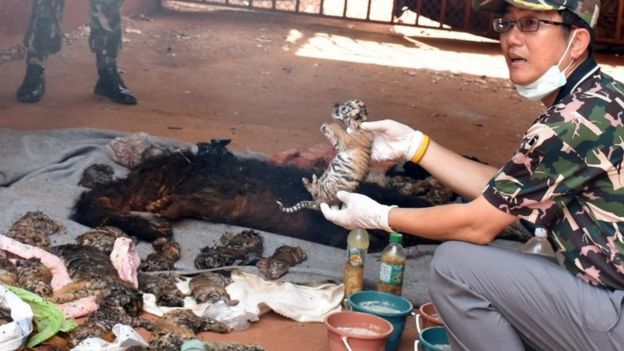
The temple has long been accused of mistreatment, though the monks deny the allegations
In a statement on its Facebook page, the temple said the mortality rate for tiger cubs at the temple was "comparatively low" and that it used to cremate dead cubs but the policy changed in 2010.
The statement did not say why the temple started freezing cubs' remains, and also denied selling cubs.
Body parts from other animals were also found in a freezer, Tom Taylor, from Wildlife Friends Foundation, told the BBC.
A reporter from the Khaosod news website said he had seen animal intestines in containers, a dead boar and other animal parts.
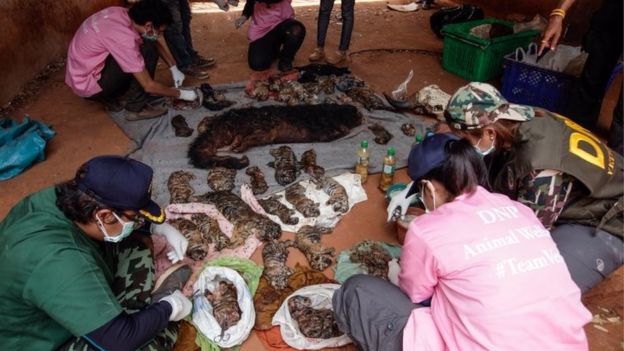
The cubs were found during a week-long raid of the temple to remove all living tigers
Dozens of living tigers have already been removed, out of 137 at the temple. The 1,000-strong police operation is due to continue all week.
Some workers and volunteers at the temple spoke out against the operation.
On Facebook, Canadian Gary Agnew, who has worked at the temple for more than a decade, said "the fatality rate could be catastrophic" as tigers were being transported in the heat of day before being fully sedated.
He said the cats were not being moved to spacious surroundings and would be auctioned off for "the highest price". He said hearing the tigers would be moved was "news worse than [staff and volunteers] could have ever dreamed".
But the World Wildlife Fund welcomed the news and called on the Thai government to prohibit the temple from keeping tigers in future.
Since 2001, authorities have been locked in a battle with the monks at the temple to confiscate the tigers after allegations of wildlife trafficking and abuse surfaced.
The monks deny any wrongdoing.
The temple, officially known as Wat Pha Luang Ta Bua, has been a stop on many tourists' itineraries for decades. Visitors could pose for photographs with the tigers or help with their exercise routine.
But animal rights campaigners have long campaigned to close it down. Peta said animals there are "imprisoned and denied everything that is important to them".
Source: bbc.com
- Read more
-
01/Jun/2016
Kenya announces Dadaab refugee camp will close by November
he world's largest refugee camp will close in November, Kenya's Interior Minister Joseph Nkaisserry has announced.
The Dadaab camp in Kenya is home to more than 300,000 Somalis.
Mr Nkaisserry said Kenya would work closely with the UN and the Somali government to repatriate the refugees.
Dadaab was set up in 1991 to house families fleeing conflict in Somalia, and some people have been living there for more than 20 years.
Kenya says it wants to close the camp over security concerns, saying attacks on its soil have been planned there.
Mr Nkaisserry said the decision was final.
Kenya did not follow through on a previous threat to close down the camp, made last April following the deadly attack by Somali militant group al-Shabab on a university 100km (62 miles) away.
The al-Qaeda linked group has staged several attacks on Kenya in recent years.
Kenya has set aside $10m (£6.8m) for repatriation, which Mr Nkaisserry insisted would carried out in a humane manner.
Source: bbc.com
- Read more
-
01/Jun/2016
Chinese stowaway found in hold of Emirates flight to Dubai
A Chinese teenager has been found hiding in the cargo hold of an Emirates passenger jet that had flown from Shanghai to Dubai.
Emirates said on Tuesday the stowaway had been found on Flight EK303 from Shanghai last Friday and had been handed over to Dubai police.
The airline did not name the stowaway but China's official Xinhua news agency said he was a 16-year-old boy named Xu.
The boy is reported to have said he was "very comfortable" in the hold.
However, he said he had eaten nothing during the nearly nine-hour flight. Gulf News said the cargo hold was pressurised.
He said he had heard that even beggars in Dubai could make a lot of money, Xinhua reported.
"We are co-operating fully with authorities in Dubai and as this is a police matter we are unable to comment further at this time," Emirates said in an emailed statement.
Xinhua said that consulate staff had been sent to the airport to learn more about the situation.
According to a translator appointed by prosecutors, the boy said he had jumped over a fence at Shanghai airport and climbed into the cargo hold while a security guard looked away, Xinhua added.
Source: bbc.com
- Read more
-
01/Jun/2016
World's longest and deepest rail tunnel to open in Switzerland
The world's longest and deepest rail tunnel is to be officially opened in Switzerland, after almost two decades of construction work.
The 57km (35-mile) twin-bore Gotthard tunnel will provide a high-speed rail link under the Swiss Alps between northern and southern Europe.
Switzerland says it will revolutionise European freight transport.
Goods currently carried on the route by a million lorries a year will go by train instead.
Switzerland's engineering triumph
The tunnel will overtake Japan's 53.9 km Seikan rail tunnel as the longest in the world and push the 50.5 km Channel Tunnel linking the UK and France into third place.
German Chancellor Angela Merkel, French President Francois Hollande and Italy's Prime Minister Matteo Renzi are due to attend the grand opening.
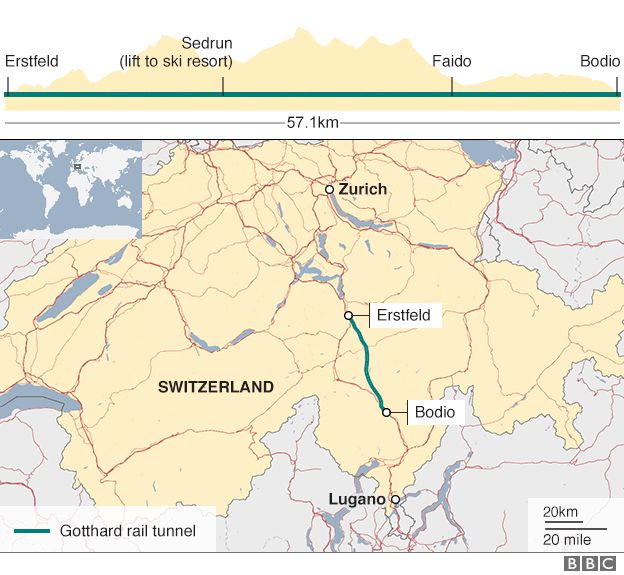
The project, which cost more than $12bn to build, was endorsed by Swiss voters in a referendum in 1992. Voters then backed a proposal from environmental groups to move all freight travelling through Switzerland from road to rail two years later.
The completed tunnel travels up to 2.3 km below the surface of the mountains above and through rock that reaches temperatures of 46C.
Engineers had to dig and blast through 73 different kinds of rock, some as hard as granite and others as soft as sugar. More than 28m tonnes of rock was excavated. Nine workers died during the work.
Now the completed tunnel - delivered on time and within budget - will create a mainline rail connection between Rotterdam in the Netherlands and Genoa in Italy.
Its trajectory will be flat and straight instead of winding up through the mountains like the old rail tunnel and a road tunnel opened in 1980.
About 260 freight trains and 65 passenger trains will traverse it in as little as 17 minutes every day once testing ends later this year.
The tunnel is being financed by value-added and fuel taxes, road charges on heavy vehicles and state loans that are due to be repaid within a decade.
Swiss bank Credit Suisse has said is economic benefits will include the easier movement of goods and increased tourism.
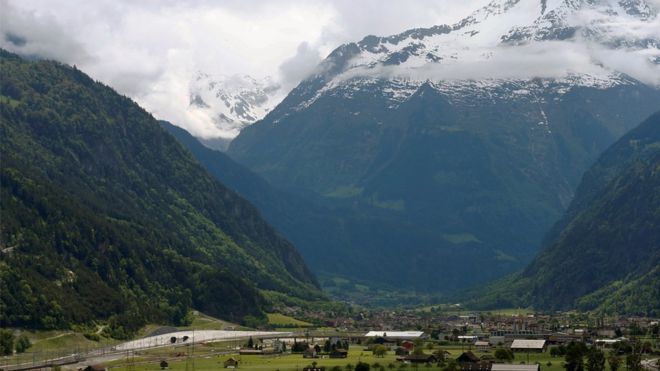
The Gotthard tunnel runs 2.3 km under the mountain at its deepest point
Source:bbc.com
- Read more
-
31/May/2016
Migrant boat rescue: Two Britons charged over Channel incident
Two British men have appeared in court charged with immigration offences after a boat carrying 20 people was rescued off the Kent coast on Sunday.
Robert Stilwell, 33, from Dartford, and Mark Stribling, 35, from Farningham, appeared at Medway Magistrates Court accused of people smuggling.
Those rescued included 18 Albanian migrants, two of them children.
An ex-chief immigration inspector said earlier people would die unless more were done to stop crossing attempts.
Mr Stilwell and Mr Stribling were charged with conspiring to facilitate the entry of non-EU nationals, and remanded in custody to appear before Maidstone Crown Court on 27 June.
The UK coastguard said it was called just before midnight on Saturday to an incident off the coastal village of Dymchurch.
Residents: 'It's a bit of a worry'
How is the UK-France border policed?
Those on board the boat reportedly alerted their families in Calais after their inflatable boat started taking in water.
Rescuers said a helicopter from nearby Lydd and two lifeboats from Dungeness and Folkestone were sent to the incident off Dymchurch.
At about 02:00 BST on Sunday, a rigid-hulled inflatable boat, known as a "rhib", with 20 people on board was found.
Trevor Bunney, who was part of the RNLI lifeboat rescue team, said the people they rescued were "a bit dishevelled, [had] obviously been at sea a long time and not in the best of conditions".
"One lady had the first signs of hypothermia," he said.
After being rescued, the group were handed over to the UK Border Force and taken to Dover.
A second vessel - which officials say could be linked to the incident - was discovered on the beach at Dymchurch.
'Not doing enough'
Since the rescue on Sunday, concerns have been raised that sea tragedies, similar to those seen on the voyage to Turkey, Greece or Italy, could occur in the English Channel.
There is an "equal chance" of migrants drowning in the Channel as in the Mediterranean, former chief inspector of borders and immigration John Vine said.
Mr Vine, who was chief inspector until 2014, said: "We have seen the tragedies that have occurred in the Mediterranean.
He added that the hazards of Channel sea traffic, weather and sea conditions "are going to mean there is an equal chance of people losing their lives unless this is stopped."
"Clearly if this is now the start of something new, then really that needs to be reassessed and resources need to be put in," he added.
Analysis
By Simon Jones, BBC correspondent
Many people living along the Kent coast are shocked, but not surprised at what's happened.
The Channel is a huge stretch of water to patrol - and the authorities are often relying on tip-offs to try to catch those responsible.
Some residents are asking how many migrants are managing to get through without being detected.
The fear is that with the recent security clampdown at the Port of Calais and Eurotunnel, more and more migrants will attempt to cross the Channel on small boats, putting their lives at risk.
At the Port of Dover, the boat from which the migrants were rescued has been painstakingly examined.
It would have been a tight fit to get 20 people on board, crammed into the small craft in the busiest shipping lane in the world.
Damian Collins, MP for Folkestone and Hythe, however, said it was "too early to say whether this is a new trend".
He told BBC Radio 5 live it was wrong to say the UK's coastline was "undefended", saying the Channel was "probably the most monitored stretch of water in the world".
'Biggest onslaught'
UKIP Leader Nigel Farage said it was "essential that a clear message is sent that no migrant arriving on our shores by boat is allowed leave to remain".
"We have all seen the horrors of the Mediterranean, with thousands crossing and hundreds dying, we cannot allow that to happen off the shores of Kent and Sussex."
Lucy Moreton, general secretary of the Immigration Services Union, which represents border agency and immigration staff, said large stretches of Britain's coastline were being left unpoliced, and officials simply did not know how many migrants have entered the country undetected.
Her "gut feeling" and anecdotal evidence suggested Britain's coasts are facing the biggest ever onslaught of people smugglers, she said.
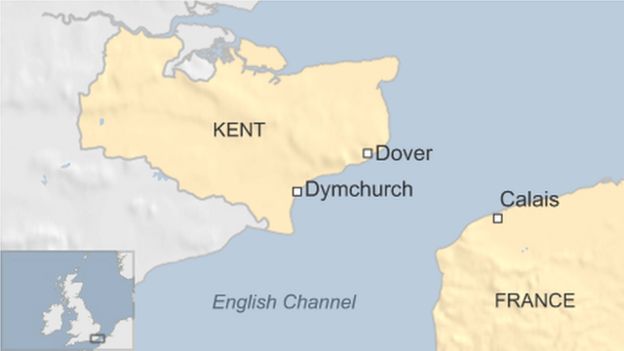
Sunday's incident comes after 17 men, thought to be Albanian migrants, were detained when a catamaran arrived at Chichester Marina in West Sussex on Tuesday, along with a 55-year-old British man wanted on suspicion of murder in Spain.
The Briton, who was the subject of a European Arrest Warrant, was detained on suspicion of facilitating illegal immigration and the 17 men were held on suspicion of entering the UK illegally.
Also last month, two Iranian men were found floating in a dinghy in the Channel.
Meanwhile, Greek coastguards rescued 29 migrants adrift off the island of Lefkada, in the Ionian Sea, as they attempted to reach Italy 150 miles (241km) away.
They are the first migrants known to have attempted the sea crossing from Greece to Italy since the northern land route via Macedonia was closed in March.
Source: bbc.com
- Read more
-
30/May/2016
The prisoner 'trapped' 10 years into a 10-month jail sentence
Justice Secretary Michael Gove has ordered a review of the position of thousands of prisoners serving a sentence known as an IPP or Imprisonment for Public Protection.
Many are considered to be languishing inside because they are several years over the minimum sentence they were given.
James Ward was given a 10-month IPP for arson in 2006. Now nearly 10 years on, he is still inside and has no release date.
He regularly self-harms, sets light to his cell, barricades himself in and has staged dirty protests. With a low IQ, and mental health problems, he cannot cope with prison life.
His sister, April, fears what he might do next.
"I do believe that one day we'll get the phone call that Jimmy has taken his own life, definitely."
'Trapped in a box'
Now 31, James has been writing to Radio 4's Today programme to explain what life is like for him inside.
"I find prison hard to cope with, being trapped in a box," he writes. "Prison is not fit to accommodate people like me with mental health problems. It's made me worse. How can I change in a place like this? I wake up every morning scared of what the day may hold."
James' teenage years were troubled. He was in and out of trouble with the police and his parents could not cope with his behaviour.
He got into a scuffle with his father, Bill, over the family dog and lashed out resulting in a year in prison for actual bodily harm. But Bill says James regrets what he did.
"He's told me it was the worst mistake he's ever made... he was young, he is a nice lad, everybody likes James," Bill says.
Close to the end of his year-long sentence, but unable to cope with prison life, James set fire to the mattress in his cell. Because of this, a judge gave him an IPP for arson and told him he would have to serve a minimum of 10 months. That was 10 years ago.
Since then, James has set light to his cell several times. His solicitor, Pippa Carruthers, says it is linked to his mental health.
"He becomes overwhelmed," she says. "He loses sight of what he needs to do to prove to a parole board that he is no longer a risk and he acts destructively."
'Kafkaesque'
IPPs were introduced by Labour in 2003. The then-government estimated the sentence would apply to 900 serious violent and sexual offenders but was actually applied far more widely and at its peak 6,000 people were serving the sentence - some for relatively minor offences such as stealing a mobile phone.
The sentence was abolished by Conservative Justice Secretary Ken Clarke in 2012 who called them a "stain" on the criminal justice system.
But 4,000 people remain in prison and nearly 400 have served more than five times the minimum term they were given.
The sentence has been called Kafkaesque as prisoners remain trapped inside because they cannot prove to a parole board that they are no longer a threat to the public.
They may have to wait years to get a parole review, or are unable to get on courses to deal with their behaviour.
Mr Clarke told Radio 4's Today programme: "It is quite absurd that there are people who might be there for the rest of their lives, in theory, who are serving a sentence which Parliament agreed to get rid of because it hadn't worked as anybody intended.
"The trouble is this ridiculous burden on the Parole Board of saying they can only release people if it's proved to them that they're not really a danger to the public.
"No prisoner can prove that - you never know when people are going to lose their control, what's going to happen to them when they're released."
He added that the key thing was to protect the public by making sure fewer criminals go on to reoffend, through helping them find work and accommodation upon release from jail.
Michael Gove has now asked chairman of the parole board Nick Hardwick to review how IPP prisoners are treated.
While the justice secretary has said that dangerous offenders must be kept inside, he says he wants the majority of IPP prisoners to be "given hope and a reason to engage in rehabilitative activity". He wants to see the prison population reduced.
'Lost and confused'
James' mother, father and sister visited him recently in prison. They said they were worried by his appearance describing him as "lost and confused".
The Parole Board has not reviewed James' case for two years and because the system has failed to carry out a required psychological and psychiatric assessment of him, it could be another year before he gets a parole board hearing.
He could be in prison for several more years.
In his last letter to the Today programme, James said he felt like he was "rotting" in the prison system.
Source: bbc.com
- Read more
-
30/May/2016
Tearful end to 11-year US church protest
Parishioners in Massachusetts have admitted defeat in their efforts to keep their church open, bringing to a tearful end their 11-year protest.
A group of about 100 worshippers at St Frances X Cabrini Church in Scituate have kept an around-the-clock vigil.
This month, the US Supreme Court refused to hear their final appeal against the Roman Catholic Archdiocese of Boston's decision to close it.
But on Sunday the protest came to an end at an emotional final service.
It was described as a "celebration of faith and transition" and many of the parishioners shared an embrace and cried.
As the service came to an end, quilts depicting each year of the vigil were taken from the walls of the church and carried down the aisles and out of the church door.
The archdiocese decided to close St Frances X Cabrini and more than 75 other parishes due to dwindling attendances, a shortage of clergy and buildings in decline.
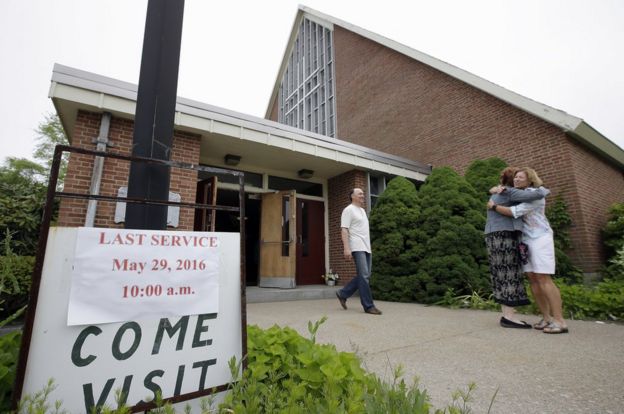
Worshippers fought a decade-long fight to prevent the church closing
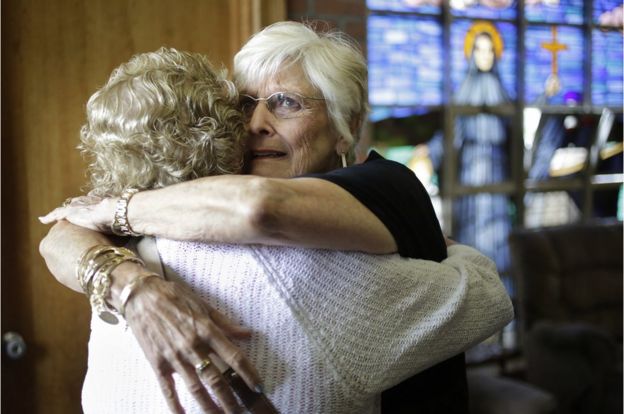
Nancy Shilts hugs another parishioner before the final service
Several of the churches earmarked for closure held vigils in protest but St Frances X Cabrini was the last church to keep up its occupation.
In parallel with the sit-in was a legal challenge that went through civil courts and even reached the Vatican, but all in vain.
A judge at the state's Superior Court ruled that the archdiocese was legally able to evict the protesters, as the legal owner of the property.
That ruling was upheld by the Massachusetts Appeals Court.
An archdiocese spokesman said he hoped the protesters would be able to attend another church within the district.
Source: bbc.com
- Read more
-
30/May/2016
Iraq troops in 'final assault' on Islamic State in Falluja
The Iraqi army is facing fierce resistance and counter-attacks as it attempts to storm Falluja, a bastion of so-called Islamic State (IS).
The army's dawn offensive came a week after it began efforts to retake the city, just 30 miles (50km) west of Baghdad and held by IS since 2014.
An estimated 50,000 civilians are trapped inside, with only a few hundred families escaping so far.
Meanwhile IS militants launched a wave of bombings in and around Baghdad.
The attacks in the Iraqi capital killed at least 21 people.
- How tough will it be to take Falluja?
- Falluja: Embattled city of mosques
- Islamic State: The full story
The commander of the army operation in Falluja, Lt Gen Abdul-Wahab al-Saadi, said: "The counter-terrorism troops along with other armed forces and Anbar [province] police have started pushing into the city. Violent clashes took place on the outskirts."
The Iraqi air force and international coalition jets carried out strikes in support of ground troops.
IS is thought to have about 1,200 fighters, the majority from the city itself.
The BBC's Jim Muir in Baghdad says government forces have taken over two townships on the southern fringes of Falluja, but on other fronts they are some way from the edge of the city itself.
The impression is that the army is trying to close a ring of steel around the city, he says.
Militia leaders taking part have said there is likely to be a pause before the assault on the city centre begins so, to allow more civilians to escape.
There is alarm over conditions faced by civilians, with reports of people starving to death and of being killed for refusing to fight for IS.
The Iraqi military has urged those remaining to either leave the city or stay indoors, though IS is preventing civilians from fleeing.
Falluja fell to IS in January 2014, a key moment in the jihadist group's rise that saw it declare a caliphate across swathes of Iraq and Syria.
Along with Mosul, it is one of two major cities held by IS in Iraq.
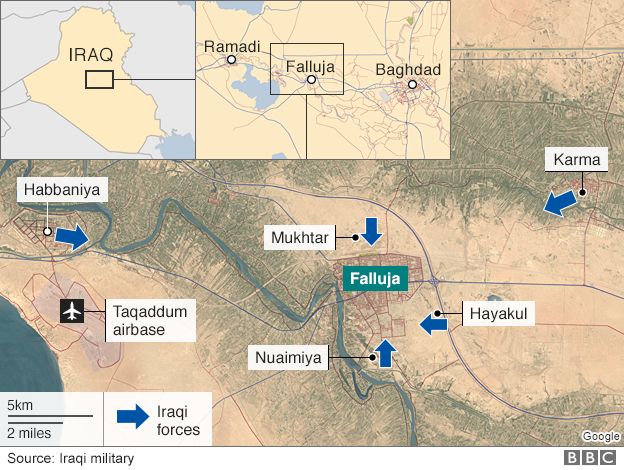
Meanwhile three districts of Baghdad have been targeted in attacks.
- In the worst incident, a car bomb detonated at an army checkpoint in the mainly Shia area of Shaab, killing at least 11 people
- Another suicide attacker, on a motorbike, targeted Sadr City, a Shia area of Baghdad, killing three people
- A suicide bomber struck a market in Tarmiya, a town 50km (30 miles) north of Baghdad, killing at least seven
All three bombings have been claimed by IS in an online statement.
IS frequently targets Shia Muslims, whom the extremist Sunni militant group regards as apostates.
The attacks may also be an attempt to deflect attention from the operation in Falluja.

Falluja - key facts:
- had population of more than 300,000 before it was seized by first al-Qaeda and then by IS in 2014
- has always been a hotbed of Sunni defiance, becoming a symbol of resistance to US forces in violent battles in 2004
- controls main highway from Baghdad to both Jordan and Syria
- is known as the "city of mosques" - more than 200 mosques in city and surrounding area
Source: bbc.com
- Read more
-
30/May/2016
Hissene Habre: Chad's ex-ruler convicted of crimes against humanity
Chad's ex-ruler Hissene Habre has been convicted of crimes against humanity and sentenced to life in prison at a landmark trial in Senegal.
The judge convicted him of rape, sexual slavery and ordering killings during his rule from 1982 to 1990.
Victims and families of those killed cheered and embraced each other in the courtroom after the verdict was given.
It was the first time an African Union-backed court had tried a former ruler for human rights abuses.
Habre, who received strong backing from the US while in power, has been given 15 days to appeal.
Survivors from the Habre era welcomed the verdict.
"This is a historic day for Chad and for Africa. It is the first time that an African head of state has been found guilty in another African country," Yamasoum Konar, a representative of one of the victims' groups, told the BBC.
"This will be a lesson to other dictators in Africa," he added.
After he was sentenced, Habre remained defiant, raising his arms and shouting to his supporters as he was led from the courtroom.
"Down with France-Afrique!" he shouted, using a term which is critical of France's influence in its former colonies.
Throughout the nine-month trial, he refused to recognise the court's legitimacy, frequently disrupting proceedings.
The ex-president denied accusations that he ordered the killing of 40,000 people during his rule from 1982 to 1990.
His critics dubbed him "Africa's Pinochet" because of the atrocities committed during his rule.
Survivors had recounted gruesome details of the torture carried out by Habre's feared secret police.
One of the most notorious detention centres in the capital N'Djamena was a converted swimming pool.
Analysis: Abdourahmane Dia, BBC Afrique, Dakar
The verdict will be seen as a major step forward by those who are campaigning for African leaders to be tried on the continent for war crimes.
They have been pushing for a permanent African court of justice to be set up, believing war crimes suspects should be prosecuted on the continent rather than at the Hague-based International Criminal Court (ICC).
But some people were critical of the AU-backed court, set up specifically to try him. They argued that it was under Western influence as it had been partly funded by the European Union and US.
However, survivors of Habre's atrocities did not seem to care who funded the court. They were just relieved that justice had been done, 25 years after his rule ended.
His critics dubbed him "Africa's Pinochet" because of the atrocities committed during his rule.
Survivors had recounted gruesome details of the torture carried out by Habre's feared secret police.
One of the most notorious detention centres in N'Djamena was a converted swimming pool.
Witnesses said victims endured electric shocks, near-asphyxia, cigarette burns and having gas squirted into their eyes.
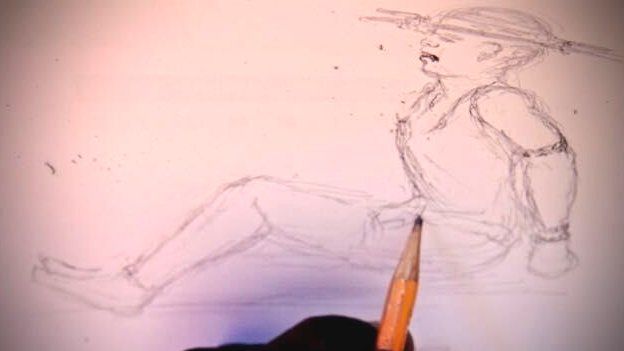
Victims drew sketches of torture techniques for the case
Some were subjected to "supplice des baguettes" (torture by sticks), when the victim's head is put between sticks joined by rope which is then twisted.
Gberdao Gustave Kam, president of the special court, said Habre had also committed three acts of rape.
Habre was arrested in Senegal, where he was exiled, in 2013.
Many of his victims campaigned for him to be tried following his overthrow in 1990.
"Today will be carved into justice as the day that a band of unrelenting survivors brought their dictator to justice," said Reed Brody from Human Rights Watch, who has worked on the case for 17 years and was in court for the judgement.
In 2005, a court in Belgium issued a warrant for his arrest, claiming universal jurisdiction but, after Senegal referred the issue to the African Union, the AU asked Senegal to try Mr Habre "on behalf of Africa".
In 2013, a court in Chad sentenced him to death in absentia for crimes against humanity.
Who is Hissene Habre?
• Born in 1942 to ethnic Toubou herders in northern Chad
• Given scholarship to study political science in France
• First came to the world's attention in 1974 when his rebels captured three European hostages to ransom for money and arms
• Seized power in 1982 allegedly with the help of the CIA
• Ousted by current President Idriss Deby in 1990
• Accused of systematically persecuting groups he distrusted
Source: bbc.com
- Read more
-
30/May/2016
At least 6 dead, 2 missing after floods in Texas, Kansas
HOUSTON – Authorities in central Texas found two more bodies along flooded streams Sunday, bringing the death toll from flooding the state to six.
It's unclear whether a body found in Travis County near Austin is one of the two people still missing in Texas. An 11-year-old boy is still missing in central Kansas, too.
The latest flooding victim identified by authorities was a woman who died when the car she was riding in was swept from the street by the flooded Cypress Creek about 1:30 a.m. Sunday, Kendall County sheriff's Cpl. Reid Daly said.
The car, with three occupants, was in Comfort, about 45 miles north of San Antonio. The driver made it to shore, and a female passenger was rescued from a tree. But Daly said 23-year-old Florida Molima was missing until her body was found around 11 a.m. Sunday about 8 miles downstream. She becomes the sixth flood-related death in Texas this Memorial Day weekend.
In Bandera, about 45 miles northwest of San Antonio, an estimated 10 inches of rain overnight led to the rescues of nine people. The rain caused widespread damage, including the collapse of the roof of the Bandera Bulletin, the weekly newspaper, KSAT-TV in San Antonio reported. Photos from the area showed campers and trailers stacked against each other, but no injuries were reported.
Torrential rains caused heavy flash flooding in some parts of the U.S. over the last few days, and led to numerous evacuations in southeast Texas, including two prisons. But the threat of severe weather has lessened over the long Memorial Day holiday for many places, though Tropical Depression Bonnie continued to bring rain and wind to North and South Carolina.
Near Austin, a crew aboard a county STAR Flight helicopter found a body Sunday on the north end of a retention pond near the Circuit of the Americas auto racing track, which is close to where two people were reported to have been washed away by a flash flood early Friday, Travis County sheriff's spokesman Lisa Block said. The body still must be recovered and no identification has been made.
To the southeast along the rain-swollen Brazos River near Houston, prison officials evacuated about 2,600 inmates from two prisons to other state prisons because of expected flooding, Texas Department of Criminal Justice spokesman Jason Clark said. Inmates in a low-level security camp at a third prison in the area are being moved to the main prison building, Clark said.
All three prisons are in coastal Brazoria County, where the river empties into the Gulf of Mexico.
"TDCJ officials continue to monitor the situation and are working with our state partners as the river level rises," Clark said, noting that additional food and water has been delivered to prisons that are getting the displaced inmates and sandbags have been filled and delivered to the prisons whereflooding is anticipated.
Another prison that's about 70 miles northwest of Houston saw a brawl between inmates and correctional officers on Saturday that began when flooding caused a power outage. Clark estimated as many as 50 inmates in the 1,300-inmate prison were involved.
The rising water in several Houston-area rivers and creeks prompted Harris County officials on Saturday to ask about 750 families in the Northwood Pines subdivision to voluntarily evacuate their homes and apartments. Officials also warned residents living near the west fork of the San Jacinto River, north of Houston, that rising waters were likely to flood homes, even those that are elevated, Sanchez said.
"The skies are clear and things look good. But we want to make sure people understand that we are not out of the woods yet. We have to keep an eye on water that's coming through our bayou system," said Francisco Sanchez, a spokesman for the Office of Emergency Management in Harris County.
In Kansas, the search for the missing 11-year-old resumed Sunday and expanded beyond the swollen creek he fell into Friday night, according to Wichita Fire Department battalion chief Scott Brown. "We are more in body-recovery mode than rescue," Brown said Saturday night.
Four people died from flooding in rural Washington County, Texas, located between Austin and Houston, where more than 16.5 inches of rain fell in some places Thursday and Friday. The bodies of two missing motorists were found Saturday in separate parts of the county, according to Judge John Brieden.
Tropical Depression Bonnie reached the South Carolina coast early Sunday, bringing heavy rain and rough tides to an area packed with tourists for the Memorial Day weekend. Forecasters say up to 8 inches of rain have fallen in parts of southern South Carolina. About 3 inches of rain fell in Charleston in 24 hours and more is expected, according to the National Weather Service.
Source: foxnews.com
- Read more
-
29/May/2016
Okinawa base imposes curfew on US troops after woman's death
The US military base on Japan's island of Okinawa has imposed a midnight curfew and a ban on alcohol after the arrest of an ex-Marine suspected of killing a Japanese woman.
There would be no "celebrations and parties while the Okinawan people are in mourning", the military said. The restrictions will run until 24 June.
Kenneth Shinzato, 32, was arrested on 19 May but has not yet been charged.
Many Okinawans resent the US base and the incident has reignited tension.
Prime Minister Shinzo Abe raised the woman's death with US President Barack Obama ahead of the recent G7 summit in Japan.
'Terrible act'
The Okinawa facility, home to some 30,000 US troops, has banned them from visiting clubs and bars and drinking alcohol off-base.
Festivals and concerts at the base have been postponed.
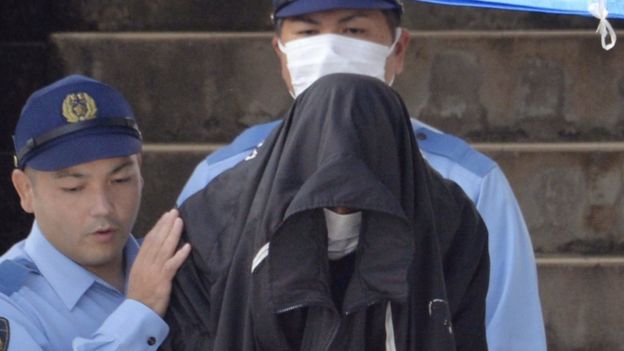
Kenneth Shinzato has not yet been charged
Marine Corps commander in Japan Lt Gen Lawrence Nicholson said at a news conference: "We should not be out shooting fireworks... If we really believe we are part of the Okinawan community, then we too must be in mourning. And we do."
He said: "There are no words in the English language that can adequately convey our level of shock, pain and grief at the loss of life of this innocent victim.
"My request to the Okinawa people is simple: please do not allow this terrible act of violence to drive a wedge between our two communities."
The ban also applies to military families and civilians employed by the military.
Kenneth Shinzato, a US military worker in Okinawa, was arrested on suspicion of dumping a woman's body.
The body of the 20-year-old woman, missing since April, was found at a location he gave.
Police say the man admitted abandoning the body. They also suspect he killed her but have not charged him with this yet.
A suspect can be held for 21 days before charges must be brought.
In 2013, US troops throughout Japan were placed under a night-time curfew after two US sailors pleaded guilty to the rape of a Japanese woman on Okinawa.
In 1995, the rape of a 12-year-old girl on Okinawa by US servicemen prompted mass protests.
The Okinawa base houses about half of all US troops in Japan. There are plans to relocate part of it - the Futenma air base - to a less-populated area of the island, but many Okinawans want the air base removed altogether.
Source: bbc.com
- Read more
-
28/May/2016
European migrant crisis: Weekly boat rescues reach 13,000
The rescue of more than 600 migrants off Libya on Saturday by a flotilla of EU ships took the weekly total to at least 13,000, Italian authorities say.
The rescues were the latest by a patrol of Italian, German and Irish ships operating in the Mediterranean.
Spring weather has led to a surge of people attempting the perilous crossing from Africa to Europe.
It is now the main migration route since an EU-Turkey deal curbed numbers sailing to Greece.
An Irish vessel saved 123 migrants from a people's smugglers' rubber dinghy on Saturday, the Irish military said, while the Italian coastguard said a German ship had carried out four rescue operations from similar unseaworthy vessels.
Meanwhile, about 4,000 migrants plucked from the sea earlier in the week arrived in Italy on Saturday. Many others are known to have drowned.
In one dramatic operation caught on camera by Italian rescuers on Wednesday, a migrant boat overturned after spotting a patrol boat. The Italian navy rescued 562 people, whil five died.
The same patrol boat rescued a further 108 migrants in another incident later that day.
On Tuesday, another 3,000 people were rescued from smugglers' boats.
Most migrants are fleeing conflict and poverty in Africa and the Middle East.
Under a European Union plan, tens of thousands of those rescued at sea were supposed to be relocated to other EU countries from Italy and Greece, where most land.
However anti-migrant sentiment in other countries have meant that few of have actually been transferred.
A note on terminology: The BBC uses the term migrant to refer to all people on the move who have yet to complete the legal process of claiming asylum. This group includes people fleeing war-torn countries such as Syria, who are likely to be granted refugee status, as well as people who are seeking jobs and better lives, who governments are likely to rule are economic migrants.
Source: bbc.com
- Read more
-
28/May/2016
About Us
-
Archives
Recent posts
News for people who want to know
- Bakus Radio resource for |Ghana & Africa music |News |Entertainment |Sports | Copyright © 2016 . All Rights Reserved.
- Designed By Fresco Software Solution Pvt. Ltd.


